When you hear the term “blog,” it’s easy to think of the big boom in the early 2000s when everyone my age had their own Blogspot profile where they shared philosophical rambles and badly-written poetry full of teenage angst.
Blogging – which is a central part of content marketing – can and should be so much more.
There’s a reason that businesses, influencers and agencies are consistently pumping out free resources like detailed blog posts, ebooks, and whitepapers full of insider knowledge even though it took them a lot of hours and a lot of money to create.
Content marketing is a great way to attract new customers to your site and build relationships with them in real, quantifiable ways over a period of time. Click To Tweet
Here’s one of the best things about content marketing: any business can use it to get these benefits. You just need to know how to implement it correctly.
I can help you there. I’m a professional content marketer who successfully helps businesses get all those benefits on a weekly basis, and in this post, I’m going to take you through how to use content marketing for your business. We’ll discuss what falls under the umbrella of content marketing, how it works, how to develop a content strategy, tools to help, and much more.
What Is Content Marketing?
Content marketing is the practice of providing free content to users in order to get them to your site and engaging with your brand. Unlike blogging, content marketing is strategic, with specific goals for everything you create. Click To Tweet
Different types of content fall under this umbrella, including:
- Blogging, which can happen on your own site or involve guest blogging for other publications, and can include text, images, infographics, and videos
- Ebooks or whitepapers, which are often used as lead magnets to capture information like a user’s email address
- Email newsletter, which can build relationships with readers and encourage them to head back to your site
- Webinars and other video content, which can help you convey your brand personality and increase user engagement
How Does Content Marketing Work for Inbound Marketing?
Inbound marketing is the practice of attracting customers through engaging, relevant content. Outbound marketing relies on sales calls, social ads, and email campaigns that actively reach out to the customer. Click To Tweet
Content marketing and inbound marketing, therefore, go hand in hand. And since more than 200 million people now use ad blockers and GDPR restrictions have tightened the hatches on outbound marketing, content marketers have an incredible advantage.
Content marketing typically brings people to you at various stages of the digital sales funnel and for different reasons. These include:
- Getting traffic through organic searches from users who see your content
- Sending traffic to your site through organic social posts
- Receiving traffic from other readers or bloggers who share the content with their friends, colleagues or other social networks
Since content marketing is all about providing useful, valuable content to readers and is easy to optimize for search engine performance (SEO), high-quality posts, ebooks, and other resources can accomplish all of these goals. And, as the data shows, it can do this particularly effectively.
If you’re wondering why a lot of big businesses have invested heavily in their blogs, on-site video libraries, or other free content they share with users, check out these stats:

And if all that’s not enough, take a look at a few of these case studies:
There’s a lot more great success stories out there that a simple Google search can help you turn up that will show you the power of content marketing. That being said, you’ll only get these results if you execute this type of marketing well.
The first step to doing that is to set your goals.
Further Reading:
How to Develop a Content Marketing Strategy
Great content is nothing without a strategy behind it, and this is the biggest marketing mistake that I see brands consistently make. They hope that having great posts, infographics, or videos will be enough on their own to magically drive results somehow (which is very vague).
A content marketing strategy is essential, and you should ideally have one in place before you start creating. Your strategy should take the goal(s) into account so you can have a big-picture view of how you want to accomplish them.
Here’s how to do that.
Choose Your Strategic Goals
Content marketing can help you accomplish a large number of very different goals. The key is to know which goals you’re trying to hit.
It goes without saying that for most brands, the ultimate goal will always be to get more customers and more sales. You can go about that in both direct and indirect ways.
Different strategic goals that you can focus on include:
- Driving immediate sales
- Getting more traffic to your site through social shares or SEO
- Improving the overall SEO of the site, thanks to new content, more keywords, and backlinks from other sites
- Building brand awareness and/or a distinct brand voice
- Establishing yourself as an industry expert or thought leader
- Generating new leads
- Increasing the number of email subscribers
- Boosting on-site engagement
Your content marketing strategy can take any or even all of these goals into account, but it’s important to note what you want to accomplish with both your overall strategy and each individual piece of content so that you can optimize for it.
Set Your KPIs
Your Key Performance Indicators (KPIs) are the essential metrics that you’ll watch in order to evaluate your progress towards your goals. These need to be specific, measurable metrics that can clearly demonstrate progress.
Not sure where to start? These are some KPIs you could be focusing on:
- Sales: Conversions, which can be tracked in Google Analytics once you set up conversion tracking.
- Site traffic: Number of site visitors, specifically to your blog posts; you can also utilize Google Analytics to see which posts are bringing in the most traffic.
- SEO authority: Your SERP ranking, which can be found and tracked with tools like SEMrush’s position tracking.
![]()
- Brand awareness and thought leadership: Use tools like Mention to track social media mentions of your brand in order to see what people are saying.
- Lead generation and email subscribers: Monitor new lead sign-ups, which can be evaluated by tracking the growth of your email list. Make sure to look at number of new sign-ups and not just overall total, because some amount of churn is normal.
- On-site engagement: Measure the comments and social shares you’re seeing happen directly from your post. These are easy to evaluate with no external tools, though social sharing counters (like this one) can help.
Optimize Your Content Accordingly
For every single post that you write, infographic you design, or video you create, you should have one specific goal in mind for it. That way, you can optimize the living daylights out of that post for that single goal. This makes it easier for you to give users actions that they can take without them feeling overwhelmed, and thus will increase the effectiveness of the individual post.
Specific actions you can take to optimize posts based on your specific goals include:
- Sales: Mention products in your posts, and include a link towards the end of the post with a strong call to action (CTA) urging them to go check it out.
- Site traffic: Encourage social sharing, and make sure you’re using diverse keywords that will best help you rank well.
- SEO authority: Link to other high-value, high-authority sites, and follow SEO best practices.
- Brand awareness and thought leadership: Link to other content that you’ve written, especially on other blogs, to show your array of knowledge.
- Lead generation and email subscribers: Place CTA buttons throughout the post to encourage email sign-ups, and use an opt-in widget on the side of the post. This can feature a lead magnet like an ebook or whitepaper if you have one.
- On-site engagement: Make it easy for users to leave comments on your site. Disqus is a great tool for this, and it’s a plugin that’s particularly good at generating not only comments but actual discussions.
In addition to these specific optimization practices, there are other best practices that you can (and absolutely should) apply to every blog post in some format. These include:
- Always, always having a distinct CTA at the end of every post. For maximum impact, this should be separated from the last paragraph by at least one space, and ideally highlighted, bolded, or italicized to draw attention to it. If possible, place a clickable link with specific instructions like “sign up for our ebook here” or “register for our webinar now.” The more actionable and specific, the better.
This CTA should also be directly relevant to the goal of your post. In the example below from Shakr, the goal is to get more people using a product, and that’s made clear in the CTA.
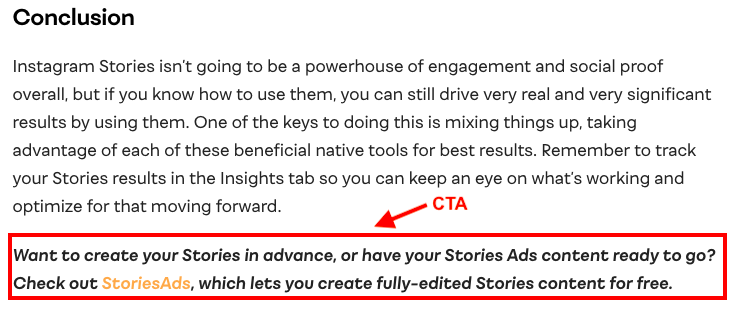
- Take advantage of social sharing bars. Social sharing bars can be installed through plugins, and they encourage social sharing. It makes it super easy for people to share your article – all the reader needs to do is click a button. This will help you distribute your post without any extra effort on your part. Some plugins even have social sharing counters, telling other readers how many people have shared, which can act as powerful social proof.

- Consider placing in-text CTAs in blogs. These CTAs can encourage email sign-ups, or have a quote from your article highlighted and ready to Tweet with the click of a button (like we’ve done throughout this post!). Clickable CTAs are much more effective, and since they look a little different from the rest of the text, they’ll stand out and be more actionable.

- Don’t forget your sidebar widgets. In most cases, your content won’t take up the whole screen. You don’t necessarily want it to (at least not on desktop) because that would be a little overwhelming. Take advantage of that extra space to the right with sidebar widgets that give you more room for email opt-in boxes and places to promote your lead magnet. You can also place these above or below your post.

Measure, Adjust & Repeat
Once your content marketing strategy is up and running and you’re publishing new posts, videos and lead magnets, it’s time to implement the KPI tracking you’ve set up so that you can see how you’re progressing towards your goals.
You’ll also want to keep a close eye on what content is performing best. Do shorter videos get more results than longer ones? Do infographics get more social shares? Do certain types or topics of posts receive more clicks on the CTA?
Google Analytics is your best friend. It’s a free tool that will tell you about everything happening on your site, including where you’re getting your traffic from, which pages they’re entering on, how they’re moving through the site, and how long they’re staying. It’s free and easy to install.
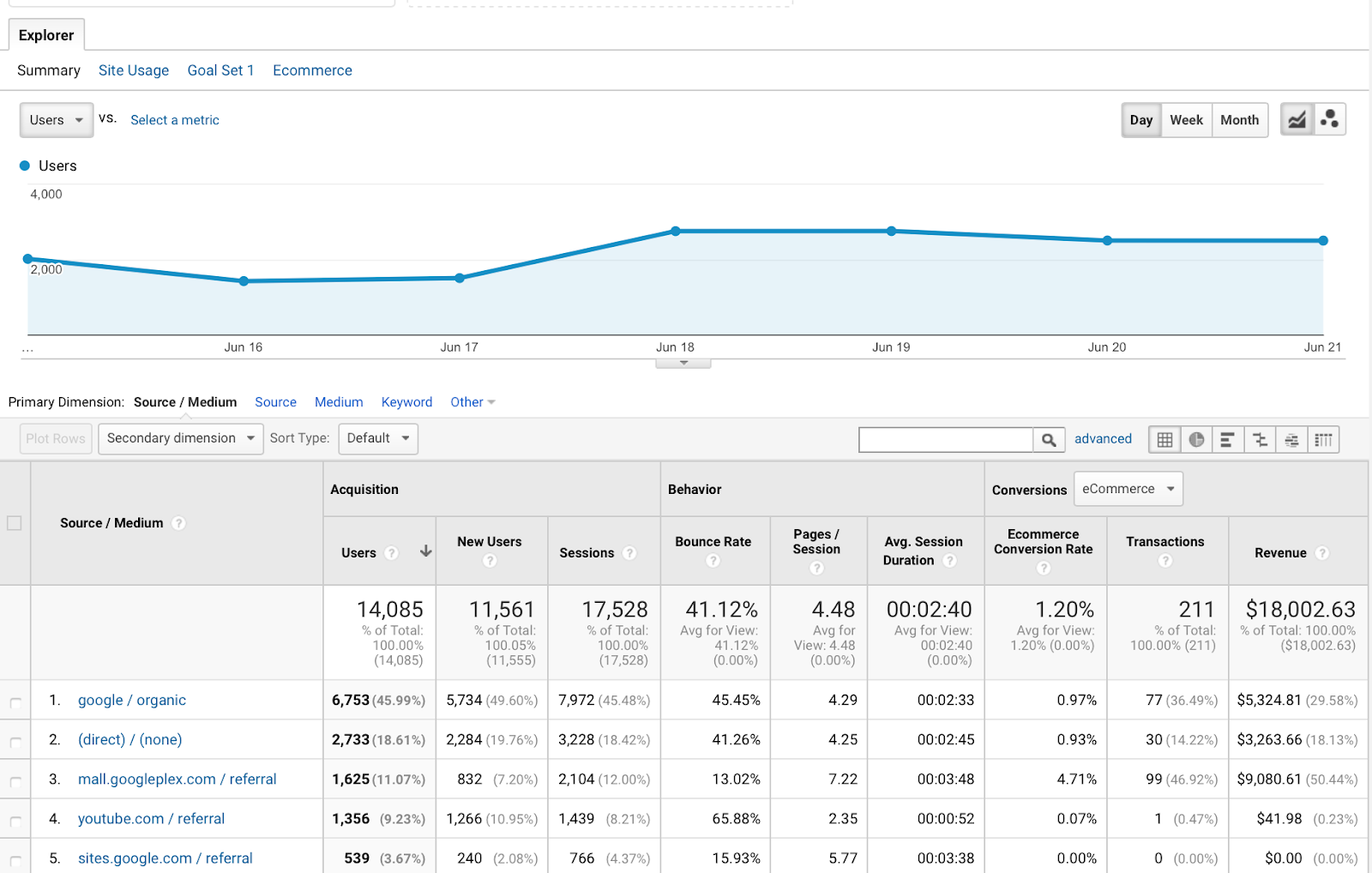
Look for trends in performance and see if you can find reasons behind why some posts, lead magnets or videos do well when others don’t.
Watch for big drop-off points that stop before or at the lead magnet in order to troubleshoot your funnel. If users make it through three blog posts but then don’t sign up for a related ebook, why? Is the ebook similar in content? Have you not optimized the landing page to explain the value of the ebook? By solving the disconnect on the landing page, you’ll be able to get more results.
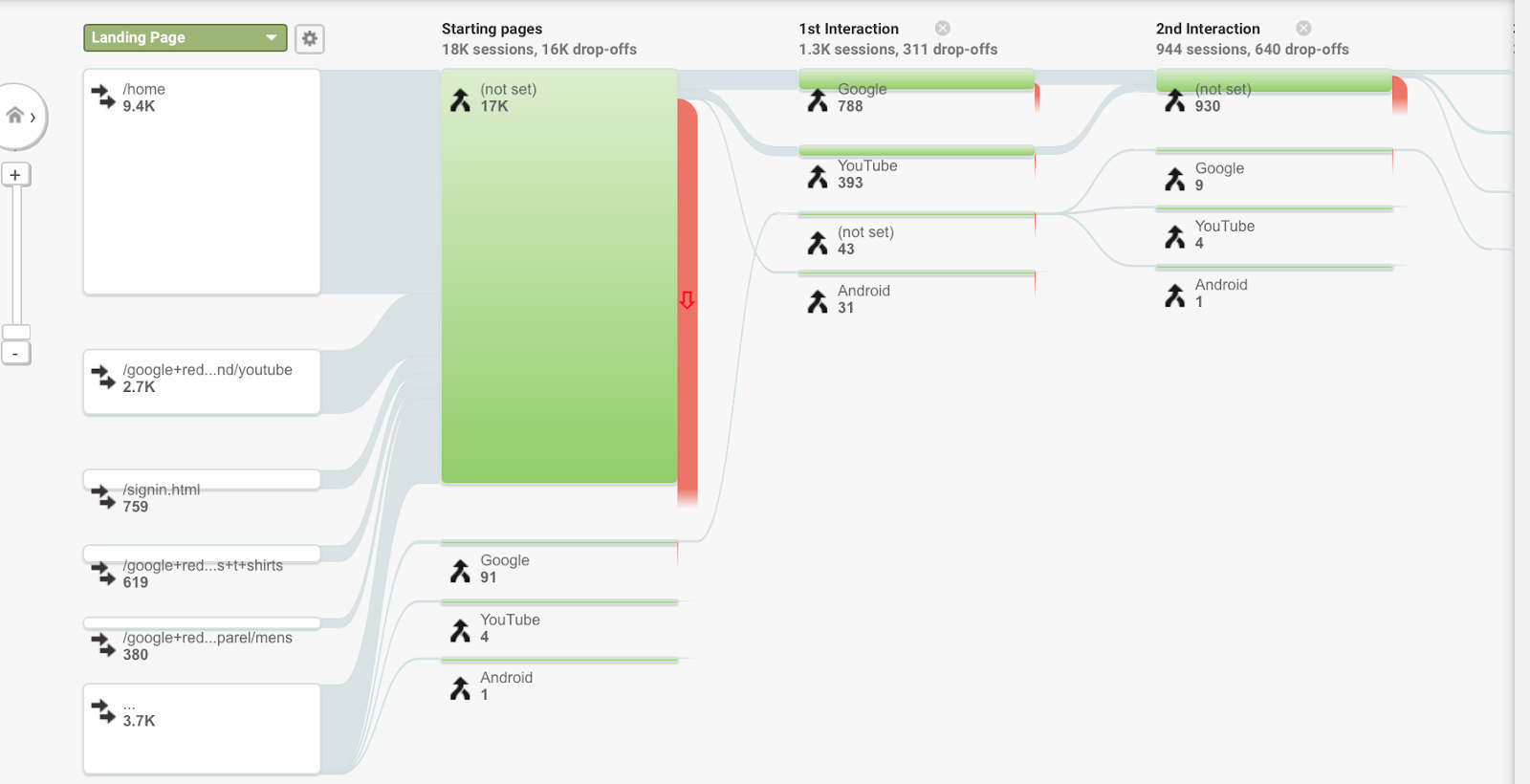
Continue to measure, analyze and adjust your content regularly. Especially with best practices in marketing changing so frequently, you can’t afford not to.
Further Reading:
Creating a Content Marketing Funnel
A single blog post or video won’t get you results on its own, even if there’s strategy behind it. Even a lead magnet can only do so much if it isn’t incorporated into a larger plan that works towards a single goal.
That’s what a funnel is for. A content marketing funnel works by using multiple touch points to attract readers and push them into different stages of the digital buyer’s journey. This should be an essential part of your strategy, and you should create different funnels to accomplish different goals (though there can be overlap in content).
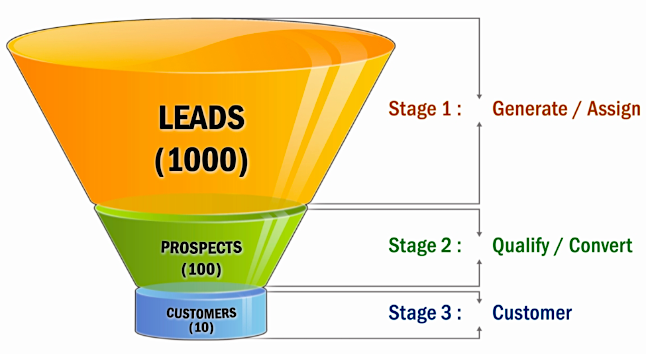
This is where it’s so important to have a distinct goal and purpose for every single blog post you write.
Let’s say you are a fitness guru. Your ultimate goal is to book more paying personal training clients, and your plan to do this is to get their email addresses to nurture leads into clients. You plan on getting these email addresses with a free ebook about a plant-based diet for muscle building, which will be available on your site.
You write the ebook as well as a series of posts that all tie in to this lead magnet. These posts can target keywords and subjects like the following:
- What kind of diets are best for muscle building, with a section on plant-based diets
- Best practices for building muscle, which has a section on diet and can link to the above post
- Changes you can make to lead a healthier lifestyle, which could link to either
These posts help to spread a wider net to catch more users looking for similar content under a number of keywords, and since this content is all free on your site, it builds trust to the point where users would feel comfortable trading their email address for the lead magnet.
Each post can include a mention to the ebook in-text, but they should all have a CTA at the end of the post to download the ebook for more information, sending users to the designated landing page. This prevents users from glossing over the link halfway through the post if they wanted to keep reading, but ensures that relevant users do make it to the landing page.
You can then share these posts on social media and even run ad campaigns to them, bringing more users to your site and getting them to sign up. Once you’ve got their email addresses, you can send them newsletters and lead nurturing campaigns to coax the relationship further and to work closer towards getting more clients.
A content funnel is all about the big-picture view, and it will make your campaigns significantly more effective.
Content Marketing Distribution: Setting a Plan
Distribution will technically be part of your content marketing strategy, but it’s important enough that I wanted to give it its own section. And there’s a reason for this.
Too much great content goes undiscovered online because the writer/business/marketer didn’t have a distribution plan in place. Hoping that people will find you through Google search is never enough, even if your site does have an incredibly high site authority and a fighting chance at top-ranking SERPs.
When it comes to content distribution, you need to be both proactive and intentional. Though the goal is to get people coming to you, you’ll still want to place your content directly in front of as many people as possible.
Social media is one of the most popular distribution methods out there. Your brand likely already has a built-in audience that’s engaged, so sharing posts, videos, and infographics with them can help drive traffic and social shares (which gets you more traffic).
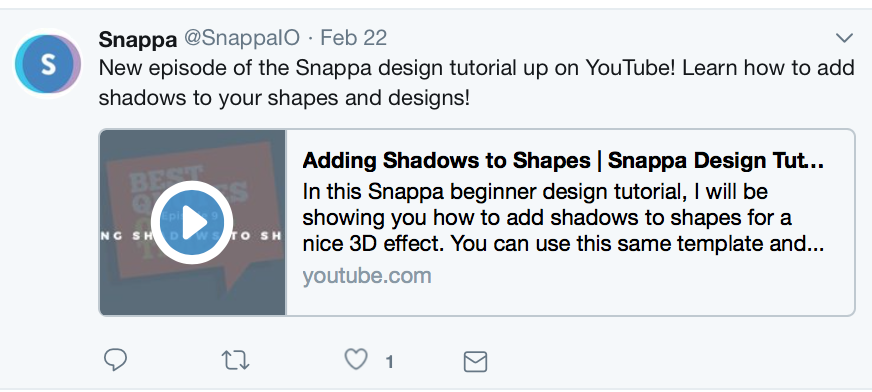
Guest posting on other sites is another common strategy, though it’s slightly less in your control. Getting your content on relevant, high-value sites gives you the opportunity to not only build your reputation and brand awareness, but also to link back to your own content. This can send you interested traffic and then keep them exploring your site for a little while.
You can share your blog posts in relevant Facebook groups and online forums, but you have to be careful with that. You don’t want to be seen as a spammer, and plenty of these venues have rules against promoting your own stuff. If someone asks a question that your recent post can address, then answer the question briefly and then say “you can read more in the full post I wrote here if you’re interested” and link to it.
If you have the budget for it, pay-per-click (PPC) campaigns are an excellent option. You can use Google AdWords to help your content climb to the top of the SERPs in relevant searches. You can also use Facebook Ads to show your content to users who meet certain targeting criteria like interest, demographics, or even their relationship with your business.
Massimofrom AdEspresso actually recommends using PPC campaigns to amplify inbound marketing, compounding the results by expanding their reach significantly.
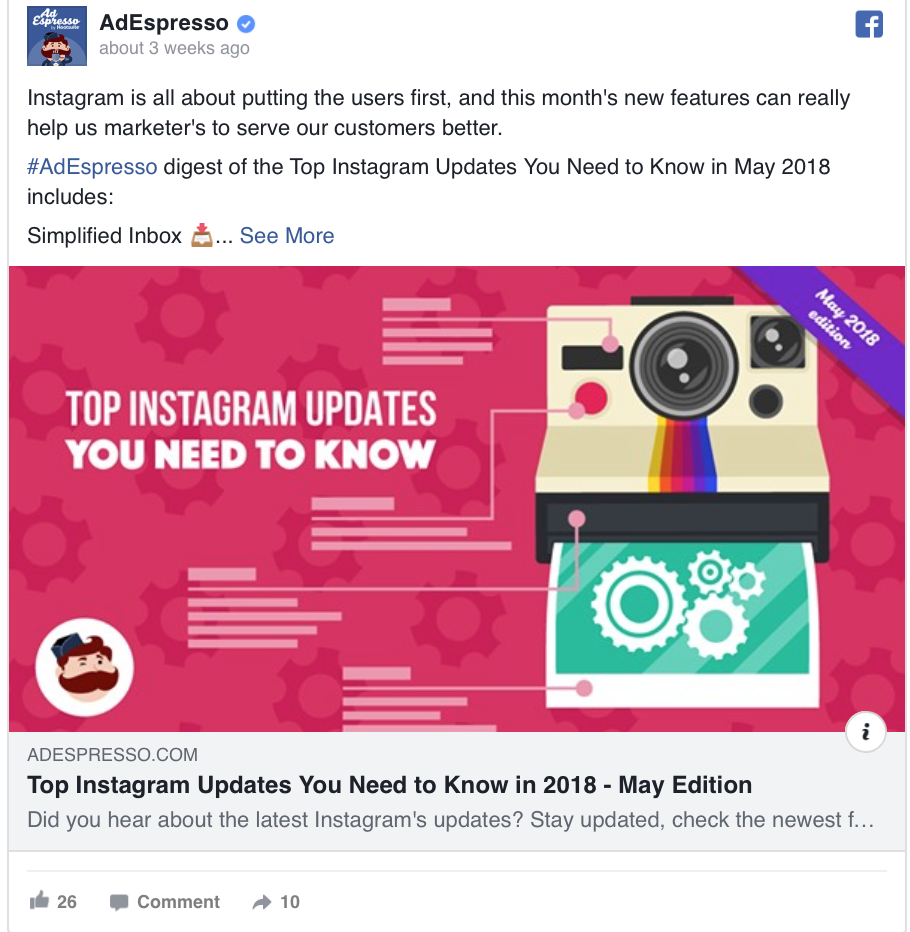
In general, adding multiple distribution methods to your plan is a good way to go. It helps you cover more ground and reach the most potential readers, which is exactly what you want.
Content Marketing Tools to Streamline the Process
If content marketing feels a little overwhelming, that’s because it’s a lot to keep up with! Whether you’re hiring a content manager, a team of freelancers, or trying to tackle it all yourself, each of the following tools will help you streamline the process and improve your results.
Collaboration Tools like CoSchedule
I’m always excited when I hear that one of my clients uses CoSchedule. It allows us to schedule posts through the interface and actually write WordPress posts, assign authorship, add tags and categories, and even schedule social sharing all in one dashboard. They also have great analytics, which is a plus.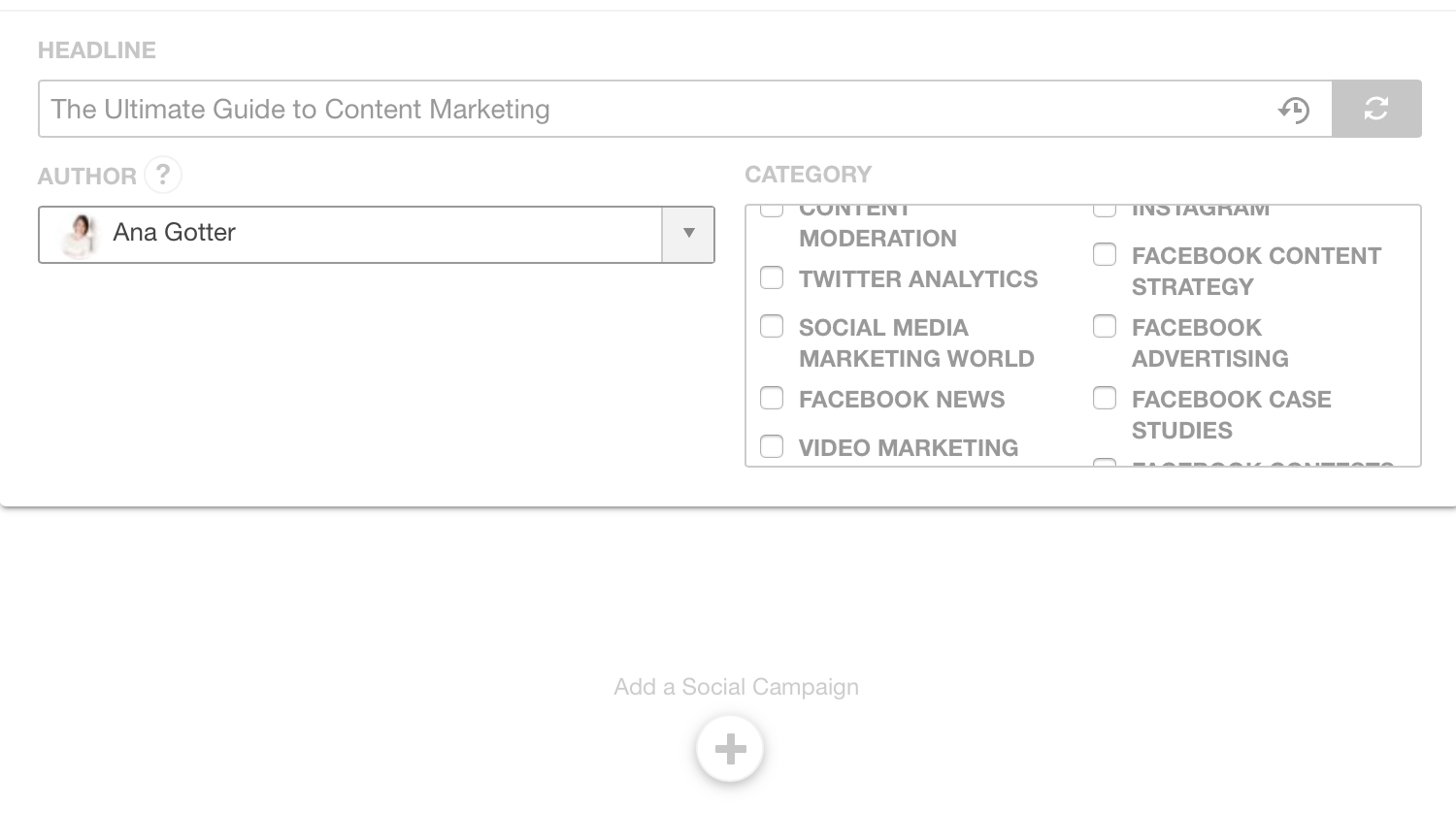
Further Reading:
Social Scheduling Tools like AgoraPulse and Hootsuite
Social media is often a key distribution method for most businesses using content marketers. Both Agorapulse (whose queue feature is pictured below) and Hootsuite are my favorite tools with similar features that include in-depth analytics and publishing abilities, and both offer free trials.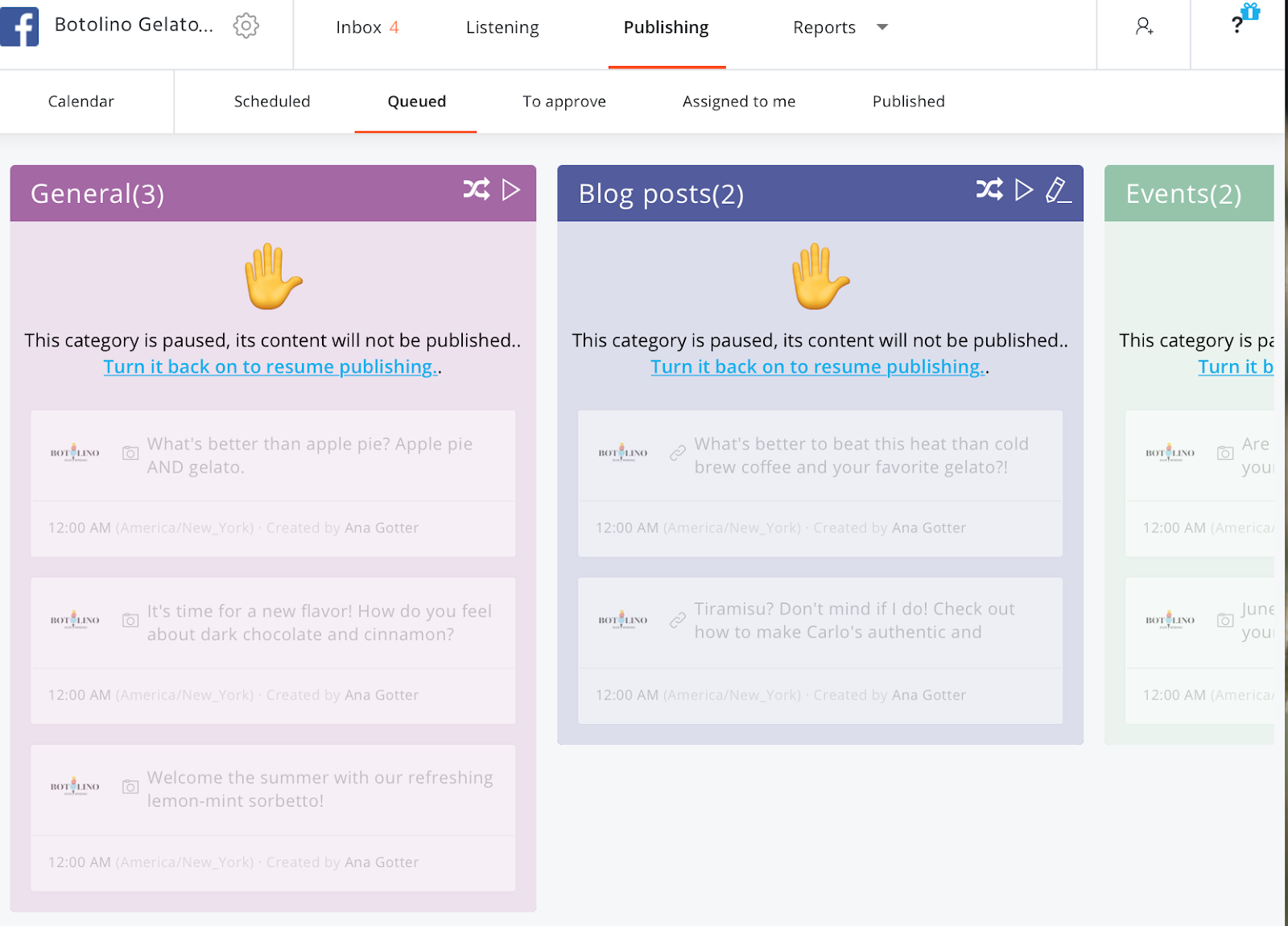
SEO Tools like the Plugin Yoast SEO
We could all use a little help making sure that our content is both readable and SEO-friendly. Yoast SEO is a WordPress plugin that’s easily my favorite to help me ensure that my content is readable by both humans and Google.
It gives you suggestions on how to improve, which is a great benefit. The only downside to this is it has to be in WordPress, and a lot of people (like me) send Google docs to clients.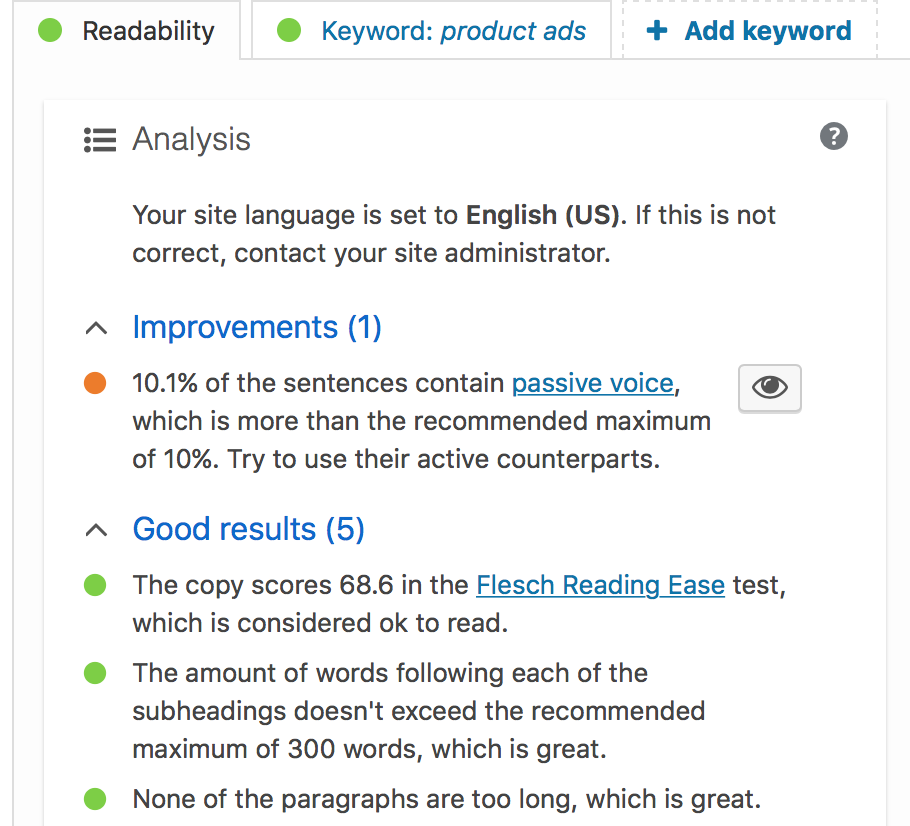
Writing Tools like Grammarly or SEMrush’s SEO Writing Assistant
Not everyone is a natural writer, and even if you are, it can still help to get a second set of eyes on your content. Tools like these will help you improve your writing (including grammar and syntax). Grammarly even offers word swap suggestions.
SEMrush’s tool (pictured below) is a mix of an SEO plugin and a writing assistant, and it will review your content for overall readability and SEO-friendliness while you’re writing in any window.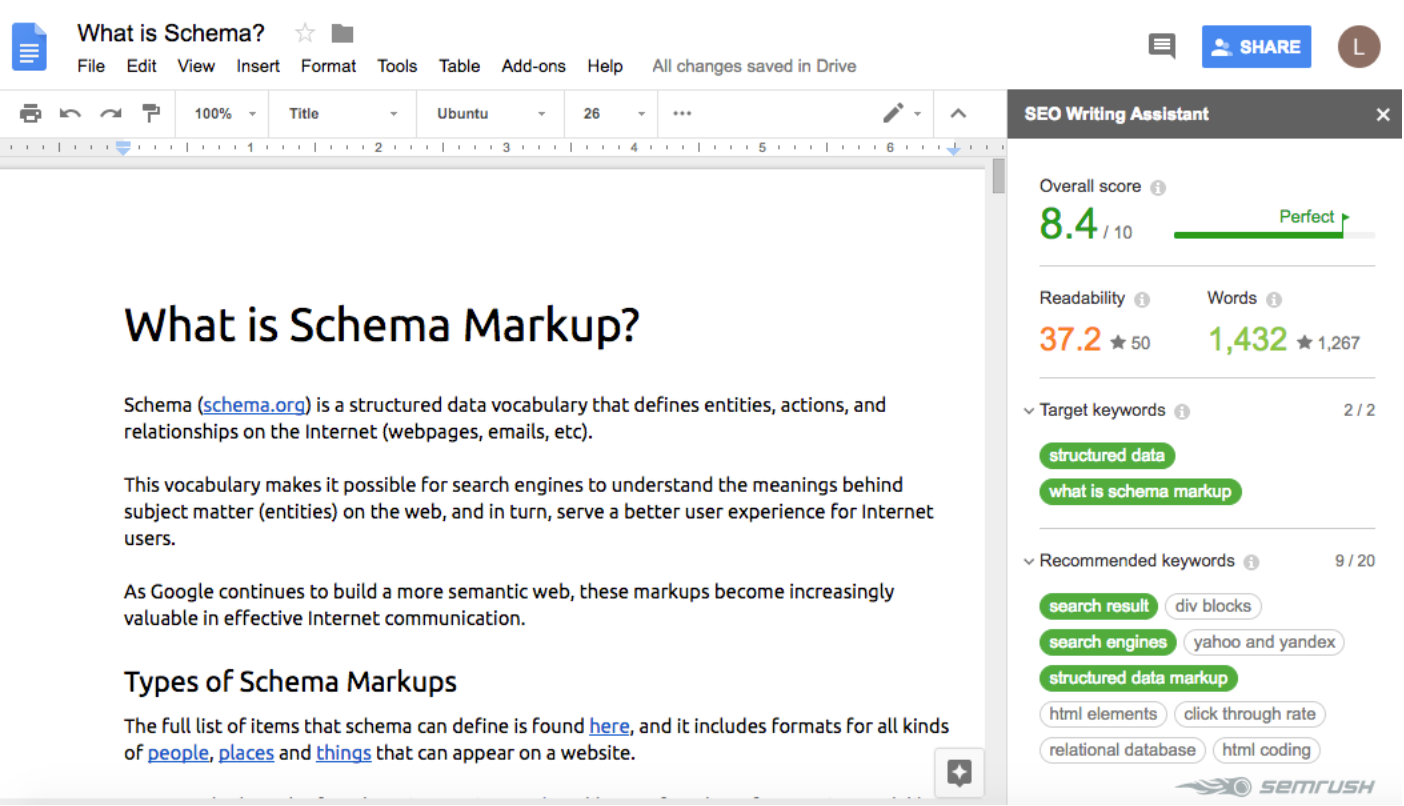
Content Marketing Mistakes to Avoid
We’ve covered pretty much everything that you should do in content marketing. Now, almost as importantly, let’s take a look at what not to do.
Some of the biggest content marketing mistakes you can make are:
- Not blogging frequently. Readers will notice when you’re not blogging consistently and see this as your not being invested in the blog, so they won’t check back as frequently. It can also pull you out of the habit, which will make writing even more difficult when you finally get around to it.
- Not developing a distinct voice. Having a stylized voice that is uniquely yours will benefit you. It is more interesting to read content from someone who doesn’t sound like everyone else. This can also help with brand building, and keep people coming back week after week. If you’re a law firm, your voice should be professional and authoritative, with a good dose of industry-specific jargon. If you’re a funky startup, your voice should probably be more casual and even humorous.
- Relying exclusively on SEO as a distribution method. This may be the biggest mistake I see in the content marketing world. People create content and then think that SEO is all that’s needed to get traffic to the site. Instead, use other distribution methods like emailing your subscriber base, sharing it on social, or even running PPC ad campaigns. This is particularly important at first, when your site authority will be lower and you need all the extra help you can get.
- Not choosing strategic goals for each individual post. You may have just one goal for your blog, or you may have four or five goals. That’s fine, but each individual blog post should be written with one specific goal in mind. Each post should be written with lead generation, or product promotion, or on-site engagement in mind. If you try to do too much, readers will get overwhelmed and not convert on anything.
- Forgetting to link to your own content. I recommend that each blog post contains 3-5 internal links to your own content and/or product pages. This keeps people bouncing around on your own site instead of bouncing off of it. It also makes it easier to establish relationships with readers long-term, and has SEO benefits.
- Forgetting to link to other people’s content. Sending users to other sites may seem counterintuitive, but it has several distinct benefits. It’s a good SEO move, it shows users that you can back up your statements with legitimate sources, and it can even foster positive relationships with other industry influencers.
Each of these mistakes can be exceptionally detrimental to your overall results and the effectiveness of your campaigns, so avoid them at all costs.
Further Reading:
Final Thoughts
Content marketing is an essential part of inbound marketing. It can help bring traffic to your site, establish relationships with potential customers, nurture leads, and even increase purchases. Whether you’re using it to demonstrate expertise or entertain users, remember that your content marketing will only be effective if you make it strategic, too. Set those goals and put plans in place to meet them.

